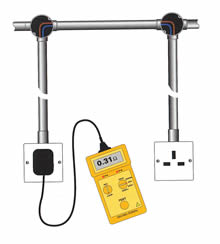Metal conduit systems in older installations are often found to have no internal circuit protective conductor (cpc) installed

Solution
Where no internal cpc is installed in a metal conduit system, the metal conduit system may have been specifically selected by the installation designer to serve as the cpc. Regulations 543.2.2 (indent vi) and 543.2.5 permit metal conduit to serve as a protective conductor for the associated circuit(s). However, Regulation 543.2.5 requires such conduit to satisfy the requirements of indents (i) and (ii) of Regulation 543.2.4, for electrical continuity and cross-sectional area (csa). Furthermore, where metal conduit system does serve as the cpc, its suitability for continued use for the purpose should be checked by inspection and testing, in accordance with Chapter 62 of BS 7671.The conduit system should, where practicable, where practicable, be inspected along its length to check for corrosion or loose joints that could impair electrical continuity or reduce the csa to such a degree that the conduit may not safely carry the prospective fault current. Where the conduit system is buried in the building fabric, removal of accessories and cover plates will provide inspection points. Where access to the conduit is difficult, further indication of the likely condition of the conduit system could be provided by considering the building construction, the environment and checking any exposed structural steel for corrosion.
Following inspection, the conduit should be tested for electrical continuity throughout its length. In addition to the tests for continuity, the earth fault loop impedance of the circuits reliant on the conduit as their protective conductor should be measured to determine whether they meet the requirements of BS 7671 for fault protection.
Regulation 543.2.2 (part of)
A protective conductor may consist of one or more of the following:(vi) A metal conduit, metallic cable management system or other enclosure or electrically continuous support system for conductors.
Regulation 543.2.4
Where a metal enclosure or frame of a low voltage switchgear or control gear assembly or bush bar trunking system is used as a protective conductor, it shall satisfy the following requirements:(i) Its electrical continuity shall be assured, either by construction or by suitable connection, in such a way as to be protected against mechanical, chemical or electrochemical deterioration
(ii) Its cross-sectional area shall be at least equal to that resulting from the application of Regulation 543.1, or verified by test in accordance with BS EN 60439-1
Regulation 543.2.5
The metal covering including the sheath (bar or insulated) of a cable, in particular the sheath of a mineral insulated cable, trunking and ducting for electrical purposes and metal conduit, may be used as a protective conductor for the associated circuit, if it satisfies both requirements for items(i) and (iii) of Regulation 543.2.4.Regulation 621.2
Periodic inspection comprising of a detailed examination of the installation shall be carried out without dismantling, or with partial dismantling as required, supplemented by appropriate tests to show that the requirements for disconnection times, for protective devices are complied with, to provide for:(i) safety of persons and livestock against the effects of electric shock and burns
(ii) protection against damage to property by fire and heat arising from an installation defect
(iii) confirmation that the installation is not damaged or deteriorated so as to impair safety
(iv) the identification of installation defects and departures from the requirements of these Regulations that may give rise to danger
This article is extracted from Snags and Solutions Part 3 published by the: NICEIC Group
